
Blogcast: Who Should Own Pricing?
This is an Impact Pricing Blog published on January 25, 2024, turned into an audio podcast so you can listen on the go. Read Full Article Here: https://impactpricing.com/blog/who-should-own-pricing/ If you have any feedback, definitely send it. You can reach us at mark@impactpricing.com. Now, go make an impact. Connect with Mark Stiving: Email: mark@impactpricing.com LinkedIn: https://www.linkedin.com/in/stiving/
15 Maalis 20243min
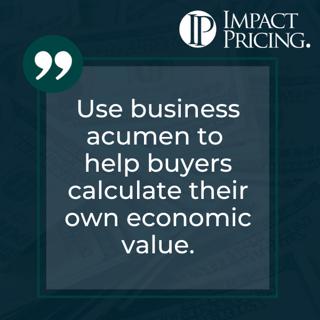
Pricing Table Topics: 8 of Hearts – Business Acumen
This one is the 8 of Hearts from the Impact Pricing card deck. Business acumen is a skill that salespeople really need, and product people really should have, to say, "Why is it that a customer would want to buy our product?" In B2B, value is measured in incremental profit. Your customer isn't going to buy anything from you, assuming it's a business customer, unless you are making them more money. Here's the question, how are you making them more money? Somehow, when you can communicate that, when your sales team can communicate that, you have a much better chance at winning the business. And by the way, when you understand it, you have a much better chance at delivering great marketing messages, and building the right products. We really need the skill of business acumen so we can say what is the business of our customers and how is it that we make them more money, because that is where the value is. We hope you enjoyed this example of Pricing Table Topics. What you just heard was done without a script. If you have any questions or feedback, please email me, mark@impactpricing.com. Now, go make an impact. Connect with Mark Stiving: Email: mark@impactpricing.com LinkedIn: https://www.linkedin.com/in/stiving/
13 Maalis 20241min
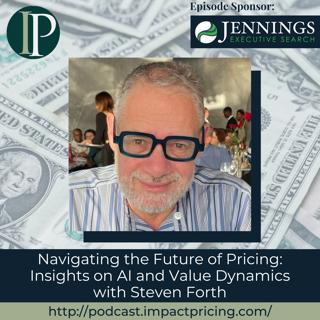
Navigating the Future of Pricing: Insights on AI and Value Dynamics with Steven Forth
Steven Forth is Ibbaka's Co-Founder, CEO, and Partner. Ibbaka is a strategic pricing advisory firm. He was CEO of LeveragePoint Innovations Inc., a SaaS business. In this episode Steven shares the shifting landscape for pricing professionals, emphasizing the rising importance of pricing strategists over analysts in leveraging AI for value-centric decision-making. Additionally, he highlights the possibilities beyond automation to include real-time recalibration of value models, enabling companies to better adapt to changing customer needs and market dynamics. Why you have to check out today's podcast: Discover the importance of custom packaging solutions designed to meet the unique needs of diverse users, adding significant value to their experience and allowing for optimized pricing strategies Find out how AI is impacting pricing strategies Understand the evolving role of pricing people: pricing analysts and pricing strategists "What pricing people should be doing today is learning how to have productive conversations with AI agents." - Steven Forth Topics Covered: 02:44 - Discussing about platform pricing and solution pricing in the context of AI 05:40 - The challenge that pricing platforms presents when it comes to quantifying value for all users 07:06 - Generative AI versus computational knowledge AI in the case of Wolfram Alpha 10:20 - Highlighting the value of packaging solutions tailored to specific needs which can be more valuable to users 12:06 - What goes in the pricing world with AI around 18:38 - Pricing strategists becoming increasingly important, need for better systems to facilitate meaningful conversations and decision-making 20:11 - Would it be possible for AI to make people inside the company understand what value is to customers 24:08 - Six types of value drivers according to Ed Arnold 27:03 - The challenge of building large amount of value models 30:20 - Steven's best advice to pricing people 31:12 - Building a value model through client interviews Key Takeaways: "Why don't people focus more on value? I think part of this is because many of us find it easier to look inside our own company than outside to our customers." - Steven Forth "In an uncertain world, having options and being able to generate options gives you a much more adaptive and resilient business." - Steven Forth "They [pricing people] need to be learning how to ask the AI questions. They need to be learning how to train the AI so that it can better answer those questions." - Steven Forth "They [pricing people] need to be understanding the strengths and weaknesses of the answers they're going to get. Because like it or not, you are going to be using an AI, you are using an AI, in your work today, even if you're not aware of it." - Steven Forth People/ Resources Mentioned: Wolfram Alpha: https://www.wolframalpha.com Stephen Wolfram: https://www.stephenwolfram.com Mathematica: https://www.wolfram.com/mathematica/ Pros: https://pros.com Zilliant: https://zilliant.com Ed Arnold: https://www.linkedin.com/pulse/how-quantify-value-service-ed-arnold/ McKinsey: https://www.mckinsey.com Microsoft Co-Pilot: https://copilot.microsoft.com Connect with Steven Forth: LinkedIn: https://www.linkedin.com/in/stevenforth/ Email: steven@ibbaka.com Connect with Mark Stiving: LinkedIn: https://www.linkedin.com/in/stiving/ Email: mark@impactpricing.com
11 Maalis 202432min

Blogcast: Listen to Your Market, then Think
This is an Impact Pricing Blog published on January 18, 2024, turned into an audio podcast so you can listen on the go. Read Full Article Here: https://impactpricing.com/blog/listen-to-your-market-then-think/ If you have any feedback, definitely send it. You can reach us at mark@impactpricing.com. Now, go make an impact. Connect with Mark Stiving: Email: mark@impactpricing.com LinkedIn: https://www.linkedin.com/in/stiving/
8 Maalis 20244min
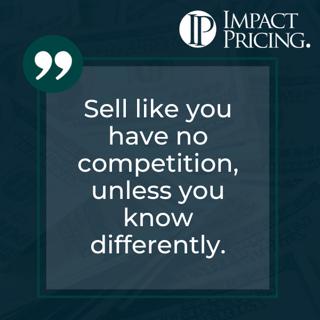
Pricing Table Topics: 8 of Spades – Sell Like You Have No Competition
This one is the 8 of Spades from the Impact Pricing card deck. You've probably heard me use the words 'will I' and 'which one' in the past. 'Will I' are situations where our buyers are choosing to buy our product or not, but they're not choosing whether they buy our product or a competitor's product. When we can find ourselves in a 'will I' situation, we know that our customers are not price sensitive. So, the key here is to know the difference. Are they comparing us to competitors or not? My recommendation is assume they're not. Because if we assume they are, we start talking about who our competitors are and they say, "Oh, you have competitors, let me go look at them." Instead, we talk to them about the value of solving the problem and why our product is going to help them solve that problem and get a huge return. And we never even mentioned that a competitive alternative exists. When the customer says to us, "Oh, we're looking at X, Y, Z company." Then we know that we can shift to talking about how we're better than our competition. What are those features or capabilities that we do that our competition can't match? But up to that point, let's make the assumption there is no competition. In fact, my favorite way to find out the answer, is there competition, is to ask the following question, "If you don't buy this, what will you do?" Notice that that question implies there is no competition. It doesn't say that go look at the competition. So my recommendation, always assume there is no competition. Talk about the value of solving the problems, and then you can shift your sales technique after you realize competition is in the deal. We hope you enjoyed this example of Pricing Table Topics. What you just heard was done without a script. If you have any questions or feedback, please email me, mark@impactpricing.com. Now, go make an impact. Connect with Mark Stiving: Email: mark@impactpricing.com LinkedIn: https://www.linkedin.com/in/stiving/
6 Maalis 20242min

Exploring Game-Changing Pricing Dynamics for Different Industries with Arnab Sinha
Arnab Sinha is a Managing Director and Senior Partner in the Philadelphia office of Boston Consulting Group (BCG) and the North American Lead for Pricing Topic, as well as Global Lead for Revenue Management. In this episode, Arnab shares what's behind writing the book 'Game Changer' and discusses how the pricing strategy frameworks discussed inside the book works for the different industries like software, consumer packaged goods, pharmaceuticals, among others. Why you have to check out today's podcast: Discover how to create value across diverse industries and implement innovative pricing strategies that can revolutionize your approach Uncover the innovative pricing strategies used by pharmaceutical companies to market their products Find out the crucial role of creating value to effect strategic pricing "Figure out how much value you want to share, and how you communicate that, because that's what drives long-term value creation." - Arnab Sinha Topics Covered: 01:14 - How he got into pricing and why he never regretted choosing it over mechanical engineering 03:48 - What's behind writing the book 'Game Changer' 06:21 - Pivotal role of value creation in pricing strategy as gleaned from the book 08:03 - How his pricing strategy framework be used in software companies 11:40 - Significance of understanding customer needs and tailoring offerings accordingly for both acquisition and retention, with competition in mind 14:25 - The strategic pricing approach for consumer packaged goods companies 17:34 - Understanding the 'uniform game' in the consumer packaged goods and how it is influenced by factors such as brand strength and price gap elasticity in relation to competitors 20:08 - From a static view of pricing strategy in the CPG towards a dynamic approach utilizing AI and machine learning to model the best pricing strategy 22:00 - Innovative pricing strategy in pharmaceuticals 26:42 - Pricing based on where value is created 29:22 - Arnab's best pricing advice 30:03 - Discussing on how much value should one keep Key Takeaways: "I think the competitor's price is a critical input. And this is where we weave it in through something like your brand strength and your brand equity." - Arnab Sinha "And this is where I think our belief is, it is not just about the one-time value of one transaction, but you need to think about the lifetime value of all of the consumers you will be serving." - Arnab Sinha "...at the intersection of the cost and competitive game, you need to understand if you are creating value and make a choice of how much value you want to share regardless of what game you're playing. Because in the absence of value creation, there is no transaction." - Arnab Sinha People/Resources Mentioned: Jean-Manuel Izaret: https://impactpricing.com/podcast/563-game-changing-pricing-strategies-for-long-term-success-with-jean-manuel-izaret/ Game Changer: How Strategic Pricing Shapes Businesses, Markets, and Society by Jean-Manuel Izaret and Arnab Sinha: https://www.amazon.com/Game-Changer-Strategic-Pricing-Business/dp/1394190581 SAP: https://www.sap.com Oracle: https://www.oracle.com/ph/ Quickbooks: https://quickbooks.intuit.com Microsoft: https://www.microsoft.com Coke: https://www.coca-cola.com/ph/en Pepsi: https://www.pepsi.com Walmart: https://www.walmart.com Kroger: https://www.kroger.com/ Publix: https://www.publix.com Target: https://www.target.com Pfizer: https://www.pfizer.com Connect with Arnab Sinha: LinkedIn: https://www.linkedin.com/in/arnab-sinha Connect with Mark Stiving: LinkedIn: https://www.linkedin.com/in/stiving/ Email: mark@impactpricing.com
4 Maalis 202432min
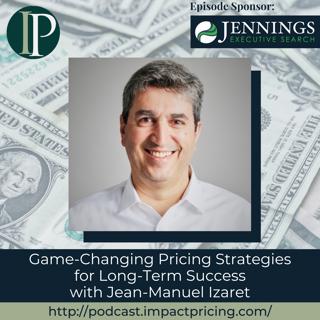
Game-Changing Pricing Strategies for Long-Term Success with Jean-Manuel Izaret
Jean-Manuel Izaret leads BCG's Marketing, Sales & Pricing practice globally. They partner with leading companies across industries to transform their commercial functions leveraging cutting edge digital and analytics capabilities to help them grow. In this episode, Jean-Manuel reveals the impact of your pricing models on maximizing your pricing strategy. Why you have to check out today's podcast: Explore the factors behind the fluctuating gasoline prices, where price rises easily when the market is up, and takes time lowering when the market is down Get an exclusive preview of the subjects discussed in the Game Changer book Discover what a 'choice game' is all about "Think about how to share the value with the market and with others, you'll bring long-term customers and loyalty, and you'll build a fantastic business for yourself." - Jean-Manuel Izaret Topics Covered: 01:36 - How he got into pricing 02:54 - Why gas price tends to go higher fast than it goes down 05:46 - Are gas price and other commodities coming back down 07:27 - What made him write the book and a sneak peak into the topics 12:29 - Important thoughts on value-based and cost pricing and identifying brands for illustration 20:29 - Relevance of elasticity in pricing 24:23 - His game of choice and why 26:45 - Industries that have huge advantage with value pricing 27:20 - Jean-Manuel's best pricing advice Key Takeaways: "It is helpful for anybody in any market to think about the value that they create for customers. And never thinking about it is usually a mistake." - Jean-Manuel Izaret "Everywhere you are, think about what people on the other side are doing, and is it relevant for you? How can you learn from that?" - Jean-Manuel Izaret "When people think about pricing, they tend to think about prices. They tend to think about the number. If you want to reframe the conversations about how you can gain more traction in the market, think about your pricing model." - Jean-Manuel Izaret People/Resources Mentioned: Game Changer: https://www.amazon.com/Game-Changer-Strategic-Pricing-Business/dp/1394190581 Shell: https://www.shell.comNetflix:https://www.netflix.com/ph-en/ Apple: https://www.apple.com Napster: https://www.napster.com/availability Sony: https://www.sony.com/en/ Connect with Jean-Manuel Izaret: LinkedIn: https://www.linkedin.com/in/izaret/ Email: jmi@bcg.com Connect with Mark Stiving: LinkedIn: https://www.linkedin.com/in/stiving/ Email: mark@impactpricing.com
26 Helmi 202429min
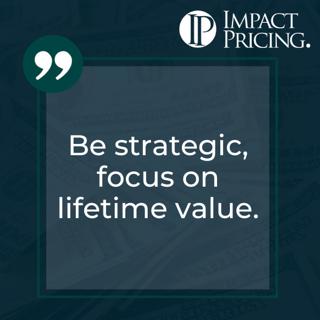
Pricing Table Topics: 9 of Clubs – Focus on Lifetime Value
This one is the 9 of Clubs from the Impact Pricing card deck. We often hear the word 'strategic' as in, "Hey, I'm making a decision today so that it grows my business someday in the future." Well, that's exactly what we want to do when we think about the lifetime value of a customer. I'm not so worried about, "Can I get the three year contract signed today?" Many companies do. But when you try to get the three year contract signed right away, you make it harder to win the customer. But what if you took a one year contract? Or what if you took a one month contract? Or even had a free trial period. And you let people get into your product, and you deliver so much value that they never leave. What we just did was get them into our ecosystem. And then over time we can get them to buy more from us, to stay with us. And that's because we know we're delivering a ton of value. This is what it means to focus on lifetime value. I'm okay taking a smaller number today because I know that over time this customer is going to grow with me and give me a whole lot more money that I'm trying to capture today. Whereas if we focus on the value of the three year contract, it's oftentimes hard to win that customer today. We hope you enjoyed this example of Pricing Table Topics. What you just heard was done without a script. If you have any questions or feedback, please email me, mark@impactpricing.com. Now, go make an impact. Connect with Mark Stiving: Email: mark@impactpricing.com LinkedIn: https://www.linkedin.com/in/stiving/
23 Helmi 20242min






















